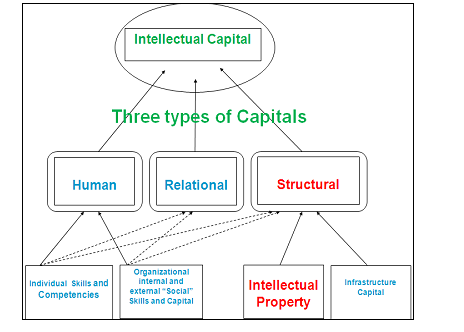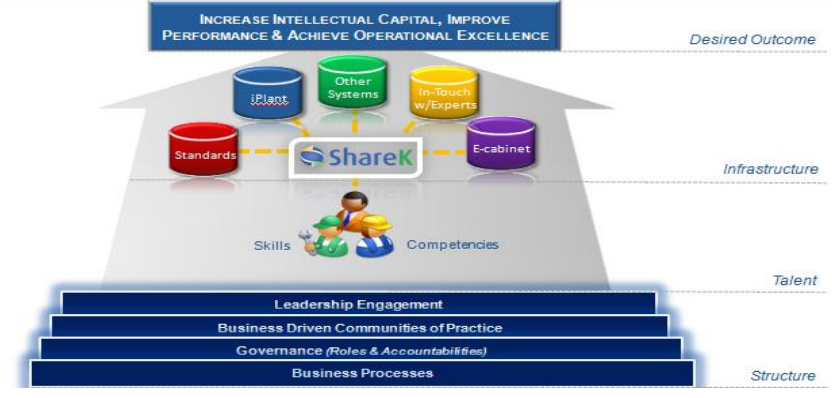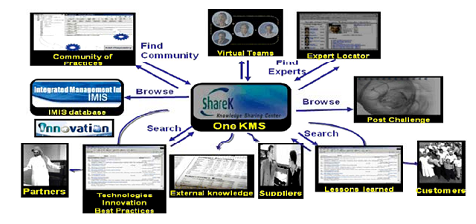Introduction
The new economy is perhaps the most striking development in business evolution over the last decade. A competitive incentive has risen from the dynamic nature and velocity of the new marketplace for both business organisations and economies in general.
Companies are increasingly being required to reconcile and consolidate their business assets, in order to create sustainable value over time. In line with these developments, Saudi Aramco is at the forefront of transforming Saudi Arabia’s economy through leveraging of intellectual capital and knowledge management.
The following study seeks to determine the structure, nature and enactment of organisational informatics in Saudi Aramco. The organisation and management of organisational informatics in Saudi Aramco, as well as the supporting systems, are also highlighted in the study.
Ultimately, organisational capabilities resulting from organisational informatics such as innovation, and drivers of knowledge management in the organization are also illustrated.
The study’s ultimate objective is to establish how knowledge management affects the capabilities of Saudi Aramco, for instance, through an intellectual capital development and innovation.
The effect of the developed capabilities on the intention of the company entering the retail market should also become apparent.
The outcome also should indicate how this development is in line with the vision of transforming Saudi Arabia into a knowledge-driven economy, considering that the organization is a national oil company.
Saudi Aramco Organisational Informatics
Organisational Informatics Definition
Organisational Informatics refers to the analyses of social informatics, with a particular emphasis on business organisations (Kling, 2000, p.217). The primary participants in the case of organisational informatics are located within bodies that can be identified.
Organisational Informatics responds to several Information Science questions within business firms’. The responses include how people relate with one another, pursue, and utilise information within the organisation.
Saudi Aramco in a bid to harness various capabilities emanating from technology has embarked on a well-designed structure of organisational informatics.
In order to accomplish this strategic goal, Saudi Aramco pursues development of absorptive capacity, a factor inherent in the company’s information systems (Khursani, Bazuhair & Khan, 2011).
Absorptive capacity entails ability to utilise prior knowledge in recognising the value of new information (Ramiller & Swanson, 2003). In addition, absorptive capacity also involves assimilating and applying the information to the creation of new knowledge and capabilities.
Saudi Aramco Intellectual Capital and Knowledge Management Infrastructure
According to Khursani, Bazuhair and Khan (2011), Saudi Aramco aims at being a human enterprise based on knowledge. The basis of the company’s system is the development of human capital in the most effective and efficient manner possible.
Saudi Aramco boasts of extensive intellectual capital resources ranging from procedures and lessons learnt from operations. Trust, brand recognition and reputation, among other factors also constitute the company’s intellectual capital.
In order to respond to industry ever-changing needs, Saudi Aramco information management system is founded on three fundamental features of intellectual capital.
Saudi Aramco intellectual capital model is based on Talent, Teams and Technology, also referred to as the 3Ts (Khursani, Bazuhair & Khan, 2011). The concept of 3Ts corresponds to the fundamental components of intellectual capital, namely structural, relational and human capital.
According to Khursani, Bazuhair and Khan (2011), these aspects have been the most substantial drivers of Saudi Aramco’s past successes. The factors are also expected to be the primary drivers of future success and sustainability of the company.
The talent aspect of the model focuses on the development of the company’s workforce for future needs. Talent also referred to as human capital comprises of creativity, expertise, competency, capability, experience and certification (Khursani, Bazuhair & Khan, 2011).
The aspect of teams, also referred to as relational capital focuses on the development of networks and interactions. Technology component also known as the structural capital entails development of standards, procedures, databases, patents, among others (Khursani, Bazuhair & Khan, 2011).
Figure 1 below illustrates the intellectual capital model utilised in knowledge management within Saudi Aramco:

Source: (Khursani, Bazuhair & Khan, 2011, p.5).
The ultimate objective of the information management system used in Saudi Aramco is to develop as well as deploy the relevant intellectual capital initiatives. The outcome should be the attainment of total value for the company.
By recognising and attaining the full value of intellectual capital solutions, Saudi Aramco would be in a position to facilitate the transformation of the country’s economy. Saudi Arabia would be transformed from being a commodity (petroleum) to a knowledge-based economy for future growth.
The 3Ts forming the basis of Saudi Aramco knowledge management and information system also corresponds to three vital infrastructural components for maximisation of intellectual capital. The factors include technical, cultural and structural.
According to Kling (2000), knowledge management systems and processes must be based on infrastructure effective in leveraging the same. The systems should be able to store, transport and transform knowledge with respect to the needs of the organisation.
Saudi Aramco ShareK (Share Knowledge)
Knowledge combination and exchange in order to create new knowledge demands presence of intellectual capital or social capital. Intellectual capital here implies all the intangible assets that enable an organisation to carry out business operations effectively (AbdulKarim, 2010).
Saudi Aramco runs an important knowledge management system referred to as ShareK (Share Knowledge). The system, also known as share knowledge portal, is used in managing the intellectual capital of the organisation (Khursani, Bazuhair & Khan, 2011).
The system is a customised product of Microsoft SharePoint. Apart from facilitating knowledge management in the company, ShareK assists in managing and sharing information and reducing redundancy within the organisation.
According to Khursani, Bazuhair and Khan (2011), the customised knowledge management system of Saudi Aramco integrates several strategies. The strategies include furthering a collaborative environment and knowledge harvesting.
The system also facilitates the development of knowledge-based organisational culture (Kings & Marks, 2008).
By addressing the talent, teams and technology aspects of intellectual capital of the organisation, ShareK has led to improved employees’ performance, and also the attainment of operational excellence(Gold, Malhotra & Segars, 2001).
Figure 2 below illustrates the various functionalities of Saudi Aramco ShareK system:

Source: (Khursani, Bazuhair & Khan, 2011, p.7).
Saudi Aramco Company Capabilities Resulting from Sharek Knowledge Management System
According to Gold, Malhotra and Segars (2001), technology forms a very crucial element of the structural dimension required to mobilise intellectual capital, in order to create knowledge within an organisation.
Apparently, the linkages provide by Sharek in Saudi Aramco integrate information and communication systems within the body. Consequently, fragmented flows of knowledge and information previously witnessed in the company were eliminated, resulting in the much-desired integration (Abdulkarim et al., 2010).
The linkages also created by the system have assisted eliminate communication barriers, which occur naturally in various parts of the organisation. According to Ramiller and Swanson (2003), institutions need to invest in infrastructure capable of supporting diverse types of communication and knowledge aspects.
Technological dimensions essential for effective knowledge management in an organisation include collaboration, business intelligence, knowledge discovery and distributed learning.
Other aspects include opportunity mapping, knowledge mapping, and ultimate security (Gold, Malhotra & Segars, 2001). All these factors have been incorporated in Saudi Aramco’s ShareK.
The structure of ShareK also plays a vital role in how knowledge is managed within the organisation. According to Ramiller and Swanson (2003), organisational structures should be designed in a manner that allows for flexibility, encourages collaboration and sharing.
The flexibility facilitates communication between boundaries within the organisation and also across the company’s supply chain. The structure of ShareK (see figure 2) is such that the organisational leadership can share with knowledge communities, the government, and other stakeholders (Kings & Marks, 2008).
Knowledge management in Saudi Aramco integrates both social and technical perspectives in the development of the company’s capabilities. The retail industry the company intends to invest in, for instance, requires major social as well as technical considerations.
According to Pan and Scarbrough (1999), the work process in an organisation forms the basis of organisational informatics. The regularities and work structures, as well as the interactions of the employees in their conformity explicitly and tacitly, form the basis of know-how.
In designing methods and means of meeting the retailing objectives, compatibility between the internal and the external aspects of the operations are key. The company through the KM system has the capability of meeting the needs of customers, through the technical and social subsystems. In addition, the company’s competitive edge is enhanced.
According to Pan and Scarbrough (1999), organisations’ adaptations to emerging information technologies inevitably calls for the retention of technical and environmental relationships.
The relationship between these two subsystems can only be enhanced through a number of organizational changes. The management infrastructure in Saudi Aramco gives the organisation the necessary told analysing and planning for the task of entering retail the market.
Saudi Aramco KM system database encompasses competitive intelligence, product knowledge, process knowledge and customer knowledge. The knowledge repository provides the capability to understand better the potential industry and the best possible approaches for market entry.
Interactions in Saudi Aramco Knowledge Management Infrastructure
Figure 3 below further illustrates the various interrelationships between Saudi Aramco stakeholders, brought about the company’s knowledge management system:

Source: (Alsereihy, Alyoubi & El Emary, 2012, p.227).
The KM systems implemented in Saudi Aramco is accessible to all members of the organisation. The line managers have the greater responsibility of ensuring employees learn and share knowledge through the system since they are closest to the workers.
Business partners, suppliers and customers also play a vital role in Saudi Aramco KM. Stakeholders contacting the company are prompted to leave feedback, recommendations and complaints through ShareK.
The senior management, human resource, managers and other experts in the organisation then review ad address the information falling under their responsibility (Alsereihy, Alyoubi & El Emary, 2012).
Alsereihy, Alyoubi and El Emary (2012), postulate that numerous support mechanisms such as communities of practice are used to facilitate KM in Saudi Aramco.
Employees connect with their communities of interest and then share knowledge. Since the employees have fast access to various technologies, they quickly communicate their issues to the communities of practice.
According to Ramiller and Swanson (2003), one of the major hurdles to effective management of knowledge in an organisation is the organisational culture. Shaping the culture of the organisation constitutes the primary ability of the firm to manage knowledge.
Based on the concept of the 3Ts, employee’s interaction is encouraged through ShareK. Both formal and informal relationships and contacts are highly recommended, such that perspectives are shared by those individuals even not working together (Kings & Marks, 2008).
Saudi Aramco employees are encouraged to self-organise knowledge and engagement in communities of practise is highly recommended. Such interaction has fostered the development of solutions to existing and new problems. In addition, the process has enhanced both generation and sharing of knowledge.
Knowledge-based organisational culture has also been improved in Saudi Aramco through explicit communication of the company’s vision (Al-Dhubaib et al., 2008).
Apparently, Saudi Aramco aims at being fully integrated through optimum utilisation of intellectual capital. The goal is also in line with the goal to transform the Saudi economy into being knowledge-driven (Jarekji, 2011).
The 3ts of Saudi Aramco intellectual capital model embraced by Saudi Aramco reflects the primary structural capabilities necessary for effective knowledge management. Talent, teams and technology are supported through the company’s structure, technology and culture.
According to Gold, Malhotra and Segars (2001), knowledge integration depends on three aspects, namely efficiency, flexibility and scope of consolidation. Saudi Aramco ShareK provides with a framework that defines the processes and aspects of integrating knowledge.
Ultimately, the processes have enhanced the ability of the company in capturing, reconciling and transferring knowledge efficiently.
Drivers and Critical Success Factors for Knowledge Management in Saudi Aramco
Knowledge management is considered a very essential strategic practice in Saudi Aramco, in regard to enhancing the company’s competitive advantage.
According to Gold, Malhotra and Segars (2001), KM assists the organization in creating, identifying, documenting, storing and redistributing knowledge, insights and experiences gained by workers (see figure 3).
The success of KM in an organization is, however, determined by various factors internal and external to the organization.
According to Alsereihy, Alyoubi and El Emary (2012), some of the drivers of successful KM in an organization include business imperative and proper architecture and vision.
Other factors driving the success of KM in Saudi Aramco include the rich technology infrastructure in which all the employees are being familiarized with (Khursani, Bazuhair & Khan, 2011).
In addition, senior management support and appointment of knowledge officers have also immensely facilitated the development of Saudi Aramco organisational informatics.
Knowledge repositories, ontology, motivational aids, and training and education are also among some of the factors that can enhance or hinder KM in an organization.
The management of Saudi Aramco emphasizes on the need for a knowledge-sharing culture, since this can become a major impediment of KM. Other barriers to effective KM in an organisation include absence of employee’s motivation and ownership of the program.
In addition, staff defection, jealousies and fear by employees that if others learn their skills they might be expendable also constitute barriers to KM (Alsereihy, Alyoubi & El Emary, 2012). Factors such as the high costs and technical requirements of setting up and running KM systems poses a major challenge.
Other Factors Supporting Knowledge Management and Intellectual Capital Development in Saudi Aramco
Although ShareK is the main system facilitating KM and IC development in Saudi Aramco, other aspects of the organisation also seek the same results. Saudi Aramco corporate structure is one of these factors.
Saudi Aramco corporate structure encompasses a project performance optimization division, focused on best practices, value engineering, development, training and benchmarking. Figure 4 below illustrates Saudi Aramco’s project performance and optimization division:

Source: (Alsereihy, Alyoubi & El Emary, 2012, p.228)
Saudi Aramco project performance and optimization division contribute immensely to the development of the company’s intellectual capital. The division encompasses sub-divisions of best practices, value engineering and development, training and benchmarking.
Integrated with the organisation’s knowledge management system, majority of the company’s intellectual properties have had their origin in this division (Alsereihy, Alyoubi & El Emary, 2012).
Emphasizes on best practices, standards and best value, information and knowledge collected and shared in this division has been very significant in the development of Saudi Aramco.
When the performance optimisation organisational function in Saudi Aramco works closely with ShareK, the emerging potential is stupendous. Cooperation between the various systems enables a number of KM outcomes.
The results include customer satisfaction, employee development, dependable external relationships and ultimately organisational success. Such results provide the company with a competitive edge and capability to venture into the retail market more effectively.
The focus by organisations on technology alone to facilitate competitiveness is not adequate enough. Saudi Aramco is balancing the focus on technology with people and processes, in order to attain the desired effective knowledge management in the organisation.
According to Alsereihy, Alyoubi and El Emary (2012), the knowledge management solution in Saudi Aramco focuses on leadership, people and process management. The leadership aspect of the knowledge management system helps the organisation and the team leaders therein enhance the knowledge sharing culture.
The management has introduced a move to convert the tacit knowledge in the organisation into explicit knowledge for better utilisation by the workers. Team managers, for instance, are encouraged to record knowledge and learning in the system.
The process management aspect, on the other hand, focuses on better understanding of the organisational processes and workflows (Alsereihy, Alyoubi & El Emary, 2012).
The move ensures that work instructions, procedures and policies, as well as inspections and monitoring aspects are encompassed in managing the developed knowledge.
The aspect of people management in Saudi Aramco ensures that staff has access to recorded information, and that simple word searches effectively reveal the desired solutions.
The overall outcome of the company’s knowledge management is extremely positive. Problems which usually take hours or days to solve are easily taken resolved in a lesser amount of time.
Consequently, the organisation is a in a position to minimise the overall amount of time expended on repairs and maintenance, translating into immense margins for the company.
Conclusion
The hallmark of new economies lies in the ability of business organisations realising economic value derived from intellectual capital. Collection of diverse knowledge assets, information production and distribution, as well as affiliation, will also play a paramount role.
Managers have no choice but to realise the competitive necessity of making their organisations knowledge-based. Considering that Saudi Aramco is a government-owned entity, the company holds a critical position in facilitating the transformation of Saudi Arabia into a knowledge-based economy.
The current initiatives are in line leveraging the company’s intellectual capital and knowledge management attest to this commitment.
References
AbdulKarim, A., Al-Dhubaib, T., Elrafie, E., & Alamoudi, M. O. (2010). Overview of Saudi Aramco’s intelligent field program. In Paper SPE 129706 presented at the Intelligent Energy Conference and Exhibition, Utrecht, The Netherlands (pp. 23-25).
Al-Dhubaib, T. A., Issaka, M. B., Barghouty, M. F., Al-Mubarak, S. M., Dowais, A. H., Shenqiti, M. S., & Ansari, N. H. (2008). Saudi Aramco intelligent field development approach: building the surveillance layer. In Intelligent Energy Conference and Exhibition. Society of Petroleum Engineers.
Alsereihy, H., Alyoubi, B., & El Emary, I. (2012). Effectiveness of Knowledge Management Strategies on Business Organizations in KSA: Critical Reviewing Study. Middle-East Journal of Scientific Research, 12 (2): 223-233.
Gold, A., Malhotra, A., & Segars, A. (2001). Knowledge Management: An Organisational Capabilities Perspective. Journal of Management Information Systems, 18(1), 185-214.
Jarekji, A. (2011). Saudi Arabia restructures oil giant Aramco. Reuters [Dubai]. Web.
Khursani, S., Bazuhair, O., & Khan, R. (2011). Strategy for Rapid Transformation of Saudi Arabia by Leveraging Intellectual Capital and Knowledge Management. Saudi Aramco Journal of Technology Winter 2011, 1-13. Web.
King, W. R., & Marks, P. V. (2008). Motivating knowledge sharing through a knowledge management system. Omega, 36(1), 131-146.
Kling, R. (2000). Learning about Information Technologies and Social Change: The Contribution of Social Informatics. The Information Society, 16(1), 217-232.
Ramiller, N., & Swanson, E. (2003).Organizing Visions for Information Technology and the Information Systems Executive Response. Journal of Management Information Systems, 20(1):13-50.
Pan, S., & Scarbrough, H. (1999). Knowledge Management in Practice: An Exploratory Case Study. Technology Analysis and Strategic Management, 11(3), 359-374.